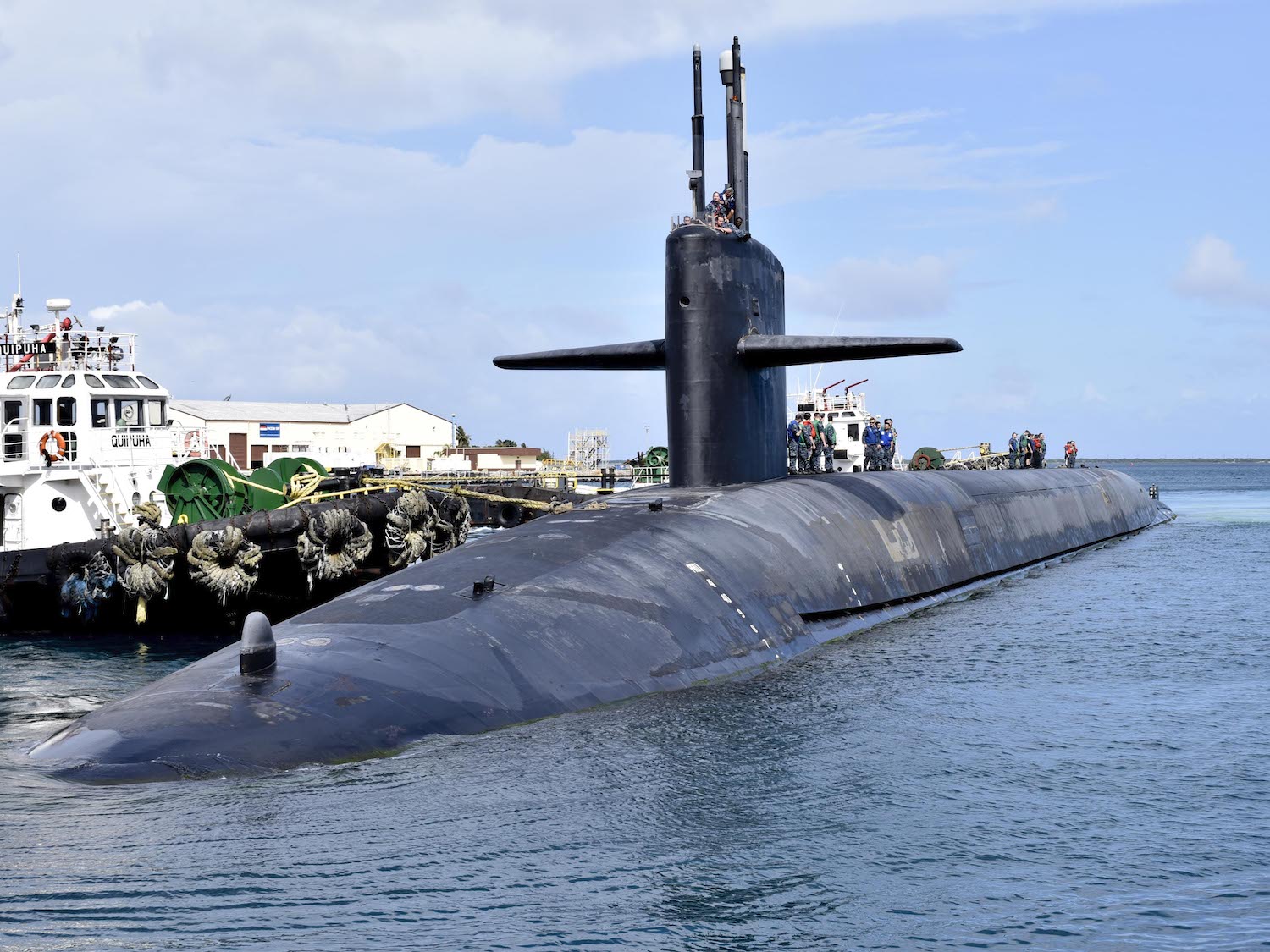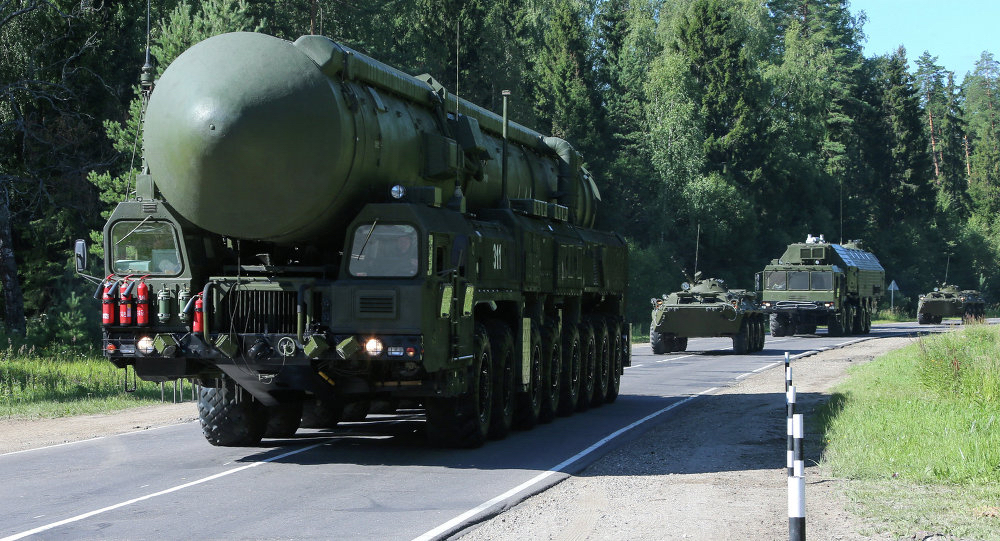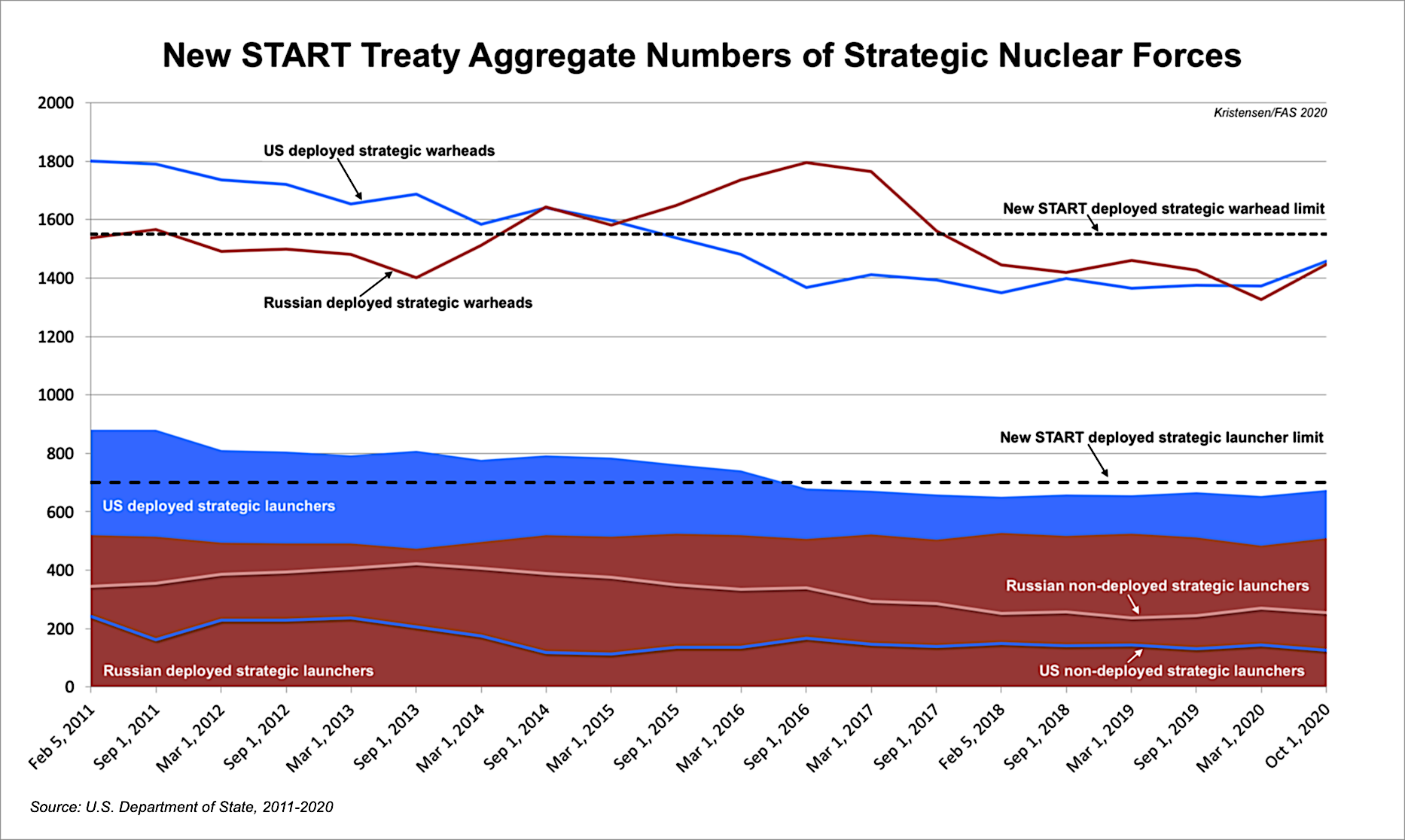
At 11th Hour, New START Data Reaffirms Importance of Extending Treaty
Just four months before the New START treaty is set to expire, the latest set of so-called aggregate data published by the State Department shows the treaty is working and that both countries – despite tense military and political rhetoric – are keeping their vast strategic nuclear arsenals within the limits of the treaty.
The treaty caps the number of long-range strategic missiles and heavy bombers the two countries can possess to 800, with no more than 700 launchers and 1,550 warheads deployed. The treaty entered into force in February 2011, into effect in February 2018, and is set to expire on February 5, 2021 – unless the two countries agree to extend it for an additional five years.
Twice a year, the two countries have exchanged detailed data on their strategic forces. Of that data, the public gets to see three sets of numbers twice a year (1 March and 1 October): the aggregate data of deployed launchers, warheads attributed to those launchers, and total launchers. This time, the web-version helpfully includes the full data set (including a breakdown of US forces; it would be helpful is Moscow could also publish its breakdown) but the PDF-version does not.
This is the final set of periodic six-month aggregate data to be released, although a final set will probably be released if the treaty expires in February. If the treaty is extended for another five years, an additional ten data sets would probably be released.
The nearly ten years of aggregate data published so far looks like this:
Combined Forces
The latest set of this data shows the situation as of October 1, 2020. As of that date, the two countries possessed a combined total of 1,564 accountable strategic missiles and heavy bombers, of which 1,185 launchers were deployed with 2,904 warheads. That is a slight increase in the number of deployed launchers and warheads compared with six months ago (note: the combined warhead number is actually about 100 too high because each deployed bomber is counted as one weapon even though neither country’s bombers carry weapons under normal circumstances).
Compared with March 2020, the data shows the two countries combined increased the total number of strategic launchers by 10, increased combined deployed strategic launchers by 45, and increased the combined deployed strategic warheads by 205. Of these numbers, only the “10” is real; the other changes reflect natural fluctuations as launchers move in and out of maintenance or are being upgraded.
In terms of the total effect of the treaty, the data shows the two countries since February 2011 have cut 425 strategic launchers from their combined arsenals, reduced deployed strategic launchers by 218, and reduced the number of deployed strategic warheads by 433. However, it is important to remind that this warhead reduction is but a fraction (less than 6 percent) of the estimated 8,110 warheads that remain in the two countries combined nuclear weapons stockpiles (less than 4 percent if counting their total combined inventories of 12,170 stockpiled and retired (but yet to be dismantled) warheads).
The United States
The data shows the United States currently possessing 800 strategic launchers, the maximum number allowed by the treaty, of which 675 are deployed with 1,457 warheads attributed to them. This is an increase of 20 deployed strategic launchers and 84 deployed strategic warheads over the past 6 months. These are not actual increases but reflect normal fluctuations caused by launchers moving in and out of maintenance. The United States has not reduced its total inventory of strategic launchers since 2017.
The warhead numbers are interesting because they reveal that the United States now deploys 1,009 warheads on the 220 deployed Trident missiles on the SSBN fleet. That’s an increase of 82 warheads compared with March and the first time since 2015 that the United States has deployed more than 1,000 warheads on its submarines, or an average of 4-5 warheads per deployed missile. Overall, this accounts for nearly 70 percent of all the 1,457 warheads attributed to the deployed strategic launchers (nearly 72 percent if excluding the “fake” 50 bomber weapons included in the official count).

The New START data reveals that the United States as of October 1, 2020 deployed over 1,000 warheads on its fleet of ballistic missile submarines.
Compared with February 2011, the United States has reduced its inventory of strategic launchers by 324, deployed launchers by 207, and deployed strategic warheads by 343. While important, the warhead reduction represents only a small fraction (about 9 percent) of the 3,800 warheads that remain in the U.S. stockpile (less than 6 percent if counting total inventory of 5,800 stockpiled and retired (but yet to be dismantled) warheads).
The Russian Federation
The New START data shows Russia with an inventory of 764 strategic launchers, of which 510 are deployed with 1,447 warheads attributed to them. Compared with six months ago, this is an increase of 25 deployed launchers and 121 deployed strategic warheads. The change reflects fluctuations caused by launcher maintenance and upgrade work to new systems.
Compared with February 2011, Russia has cut its inventory of strategic launchers by 101, deployed launchers by 11, and deployed strategic warheads by 90. This modest warhead reduction represents about 2 percent of the estimated 4,310 warheads that remain in Russia’s nuclear weapons stockpile (not even 3 percent if counting the total inventory of 6,370 stockpiled and retired (but yet to be dismantled) Russian warheads).
Compared with 2011, the Russian reductions accomplished under New START are smaller than the U.S. reductions because Russia had fewer strategic forces than the United States when the treaty entered into force in 2011.
Build-up, What Build-up?
With frequent claims by U.S. officials and nuclear weapons advocates that Russia is increasing its nuclear arsenal, it is interesting that despite a significant modernization program, the New START data shows this increase is not happening in the size of Russia’s accountable strategic nuclear forces. (The number of strategic-range nuclear forces outside New START is minuscule.)
On the contrary, the New START data shows that Russia has 165 deployed strategic launchers less than the United States, a significant gap that exceeds the size of an entire US Air Force ICBM wing. It is significant that Russia despite its modernization programs has not sought to reduce this gap by deploying more strategic launchers. Instead, the Russian launcher deficit has been increasing by one-third since its lowest point in February 2018. One factor that could change this is if the Trump administration kills New START and Russia believes the threat made by Marshall Billingslea, the Trump administration’s Special Presidential Envoy for Arms Control, that the United States might increase its nuclear forces if New START expires.

The New START data shows that Russia’s nuclear modernization program has not been trying increase the number of launchers despite a sizable gap compared with the US arsenal.
Instead, the Russian military appears to try to compensate for the launcher gap by increasing the number of warheads that can be carried on the newer missiles that are replacing older types (Yars and Bulava). Many of these warheads are not deployed on the missiles under normal circumstance, however, but stored and could potentially be uploaded onto launchers in a crisis. The United States also has such an upload capability for its larger inventory of launchers and therefore is not at a strategic disadvantage.
Two of Russia’s new strategic nuclear weapons (Avangard and Sarmat) are covered by New START if formally incorporated. Other types, which have become a sticking point for the Trump administration, are in relatively small numbers (if they have even been deployed yet) and do not appear capable of upsetting the strategic balance in the foreseeable future. The treaty includes provisions for including new weapon types.
Inspections and Notifications
In addition to the New START data, the U.S. State Department has also updated the overview of part of its treaty verification activities. The data shows that the two sides since February 2011 have carried out 328 on-site inspections of each other’s strategic nuclear forces and exchanged 20,871 notifications of launcher movements and activities. Nearly 1,200 of those notifications were exchanged since March 5, 2020.
Importantly, due to the Coronavirus outbreak, there have been no on-site inspections conducted since April 1, 2020. Treaty opponents might use this to argue that compliance with the treaty cannot be determined or that it shows it’s irrelevant. Both claims would be wrong because National Technical Means of verification also provide insight to activities on the ground, but that on-site inspections provide valuable additional data.
This inspection and notification regime and record are crucial parts of the treaty and increasingly important for US-Russian strategic relations as other treaties and agreements have been scuttled.
The 11th Hour
Time is now quickly running out for New START with only a little over four months remaining before the treaty expires on February 5, 2021. Rather than working to secure extension, the Trump administration instead has introduced last-minute conditions that threaten to derail extension.
Russia and the United States can and should extend the New START treaty as is by up to 5 more years. Once that is done, they should continue negotiations on a follow-on treaty with additional limitations and improved verification. It is essential both sides act responsibly and do so to preserve this essential cornerstone of strategic stability.
The fact that Marshall Billingslea has already threatened to increase US nuclear forces if Russia doesn’t agree to the US conditions for extending the treaty only reaffirms how important New START is for keeping a lid on US and Russian strategic nuclear forces and for providing transparency and predictability on the status and plans for the arsenals.
Additional background information:
Status of world nuclear forces, September 2020
This publication was made possible by generous contributions from the John D. and Catherine T. MacArthur Foundation, the New Land Foundation, the Ploughshares Fund, and the Prospect Hill Foundation. The statements made and views expressed are solely the responsibility of the authors.
A military depot in central Belarus has recently been upgraded with additional security perimeters and an access point that indicate it could be intended for housing Russian nuclear warheads for Belarus’ Russia-supplied Iskander missile launchers.
The Indian government announced yesterday that it had conducted the first flight test of its Agni-5 ballistic missile “with Multiple Independently Targetable Re-Entry Vehicle (MIRV) technology.
While many are rightly concerned about Russia’s development of new nuclear-capable systems, fears of substantial nuclear increase may be overblown.
Despite modernization of Russian nuclear forces and warnings about an increase of especially shorter-range non-strategic warheads, we do not yet see such an increase as far as open sources indicate.

